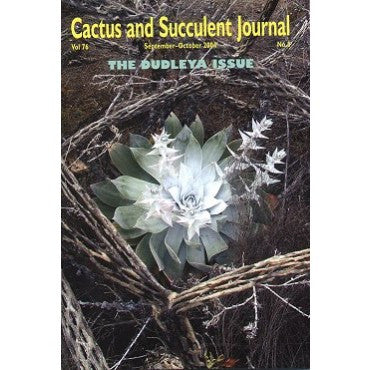CSSA
Journal Vol 76-5
Journal Vol 76-5
Couldn't load pickup availability
Sep - Oct 2004
The genus Dudleya Britton& Rose (Crassulaceae): its systematics and biology
Joachim Thiede
William Russel Dudley
Julie Cain
Looking for Dudleyas in the US
Julia Etter & Martin Kristen
History of the Journal: Dudleya
D Russell Wagner
Komodo Dragon of Dudleyas? A range extension and the case for gigantism in Dudleya candelabrum
Stephen Ward McCabe
Terrestrial barnacles (hiding in plain sight) Dudleya pulverulenta
Steven Hammer
Whence came Dudleya?
Charles H Uhl
Dudleya cymosa
Kelly J Griffin
Finding Dudleyas in Baia California
Julia Etter & Martin Kristen
Dudleya, where art thou? Dudleya distribution map
ISI dudleya offerings since 1958
Dudleya candida A chance encounter with the big form of D. brittonii, or is it the other way around?
Kelly J Griffin
On the troubles with identifying dudleyas and telling the differences among D. brittonii, D. anthonyi and D. pulverulenta
Kelly J Griffin
The rarest Dudleya species
Stephen Ward McCabe
Growing dudleyas
Dylan P Hannon
Notes on hardiness in Dudleya
Stephen Ward McCabe
Dudleya gnoma `White Sprite' What do you do with a cultivar name if the species name changes?
Stephen Ward McCabe
Dudleya growing in hot-summer climates
Leo Martin
Succulents on Stamps Crassulaceae
Peg Spaete
On the cover: Framed by the remains of a cylindropuntia, Dudleya anthonyifinds home well-hidden in thick brush in the Socorro Canyon, Baja California Norte, Mexico. The strikingly farinose leaves and unusual size (38 cm across) attracted the attention of the photographers, Julia Etter and Martin Kristen, during the early stage of flowering in May. This special issue of the journal is dedicated to Dudleya, a large genus in the Crassula family. Plants of this genus occur in a well-defined area between southern Oregon and the southern tip of the Baja peninsula, extending east only as far as Arizona. Most of the species have a small area of distribution and are known to hybridize readily (but, unlike the other North American Crassulaceae, only with other dudleyas). Their variability and hybridization make this genus difficult for taxonomic classification, Reid Moran, well-known expert on this genus, admits that more intensive study must to be conducted in order to clarify Dudleya nomenclature. People interested in Dudleya soon find out that there are not many publications available, and quality illustrations of plants in their natural habitat are scarce. We hope our approach, with a strong focus on habitat, travel and horticulture makes for a compelling introduction to these fascinating plants.


